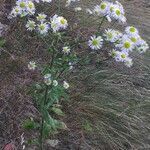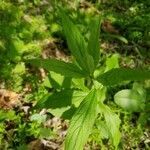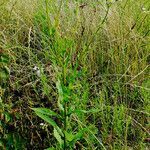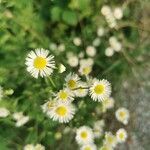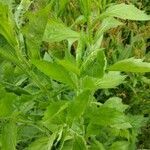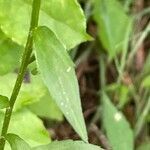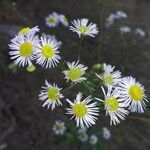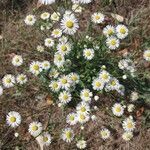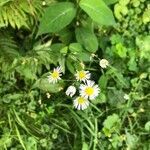Herbs, annual, [10-]30-100[-150] cm tall. Stems erect, branched in upper part, sparsely hispid, strigose above (hairs spreading). Leaves: surfaces strigose-hirsute or sometimes glabrate, eglandular; basal withered at anthesis, winged petiolate, blade elliptic or broadly ovate, rarely spatulate, 4-17 × 1.5-4 cm or more, base attenuate, margin coarsely serrate, scabrous, apex acute or obtuse; lower cauline similar, shortly petiolate, mid and upper shortly petiolate or sessile, blade oblong-lanceolate or lanceolate, 1-9 × [0.3-]0.5-2 cm, margin irregularly serrate to subentire, apex acute, uppermost linear. Capitula 5-50+, in loose paniculiform or corymbiform synflorescences, 6-8 × 10-15 mm. Involucre hemispheric; phyllaries 2-or 3(or 4)-seriate, greenish or ± brownish, abaxially sparsely hirsute, minutely glandular, subequal or outer shorter, lanceolate, 3-5 × 0.5-1 mm, herbaceous. Ray florets 80-125, 2-seriate, [4-]6-8[-10] mm, tube 1-1.5 mm, sparsely hairy above, lamina white or sometimes bluish, linear, ca. 5 × 0.6 mm, flat, tardily coiling; disk florets yellow, 2-2.8 mm, sparsely hairy, lobes glabrous. Achenes lanceolate, flattened, [0.8-]1.2 mm, sparsely strigillose. Pappus 2-seriate, outer of scales or setae, inner absent in ray florets, in disk florets of [8-]10-15 long bristles. Fl. Jun-Sep.
Annuals, (10–)60–150 cm; fibrous-rooted or taprooted. Stems erect, sparsely piloso-hispid (hairs spreading), sometimes strigose distally, eglandular. Leaves basal (usually withering by flowering) and cauline; basal blades mostly lanceolate to oblanceolate or ovate, 15–80 × 3–20 mm, margins coarsely serrate to nearly entire, faces sparsely strigoso-hirsute, eglandular; cauline lanceolate to oblong, little reduced proximal to midstem. Heads ca. 5–50+ in loosely paniculiform or corymbiform arrays. Involucres 3–5 × 6–12 mm. Phyllaries in 2–3(–4) series, sparsely villous or hirsuto-villous, minutely glandular. Ray florets 80–125; corollas white, 4–10 mm, laminae tardily coiling. Disc corollas 2–2.8 mm. Cypselae 0.8–1 mm, 2-nerved, faces sparsely strigose; pappi: outer minute crowns of setae or narrow scales, inner 0 (rays) or of 8–11 bristles (disc). 2n = 27.
Annual or rarely biennial, 6–15 dm, amply leafy; stem hirsute, the hairs spreading except near the top; basal lf-blades elliptic to suborbicular, coarsely toothed, to 10 × 7 cm, ± abruptly long-petiolate; cauline lvs numerous, broadly lanceolate or broader, all except sometimes the uppermost usually sharply toothed; heads several to very numerous; invol 3–5 mm, finely glandular and sparsely beset with long, flattened, transparent hairs; disk 6–10 mm wide; rays 80–125, white or rarely anthocyanic, 4–10 × 0.5–1.0 mm; disk-cors 2.0–2.8 mm; achenes 2-nerved; pappus of the disk-fls double, with 10–15 bristles and several very short, slender scales (visible at 20x), that of the rays-fls of short scales only; 2n=27, 54. A weed in disturbed sites over most of the U.S. and adj. Can., more common northward.
Erect annual herb. Stems ridged, sparsely to densely hairy, especially below, usually branched only above to form infl., sometimes branched from base, not rooting, 20-100-(150) cm tall. Lvs all cauline at flowering; lower cauline lvs elliptic to ovate-elliptic, apetiolate and cuneate, cuspidate, serrate, sparsely to moderately hairy, ciliate, 30-80 × 7-20 mm; uppermost lvs smaller, narrow-elliptic, sometimes obtuse at base, entire. Capitula c. 15-20 mm diam., 3-numerous in corymbs or panicles. Involucral bracts lanceolate to oblong-lanceolate, sparsely hairy, 3.5-5 mm long. Ligules linear, pale blue or white, 3.5-7 mm long. Disc yellow. Achenes sparsely hairy, c. 0.8 mm long; pappus of disc florets of 1 row of long hairs and an outer row of short scales; pappus of ray florets of short scales only.
A herb. It grows 30 cm to 1.5 m tall. The stems are erect and hairy. The lower leaves are oblong and in rings. The leaves are hairy and have teeth. They are 10 cm long. The flower heads have about 80 tightly packed white flowers. These have yellow diskes around them.
